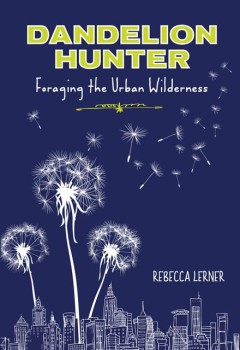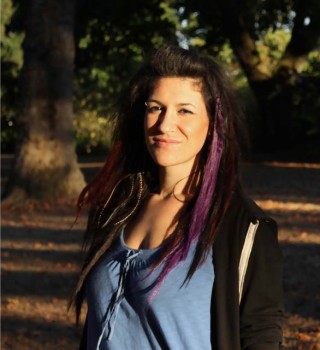 There’s a young woman who hunts dandelions and sundry other edible and medicinal wild plants out of an apartment in Portland, Oregon, relishing reconnecting with nature after a several-years-long stint sequestered indoors, surrounded by a plantless outdoors, working for a New Jersey newspaper.
There’s a young woman who hunts dandelions and sundry other edible and medicinal wild plants out of an apartment in Portland, Oregon, relishing reconnecting with nature after a several-years-long stint sequestered indoors, surrounded by a plantless outdoors, working for a New Jersey newspaper.
We happen to share the same name—a similar moniker, anyway, her being Wild Girl, purveyor of the popular wild edible internet weblog, www.firstways.com, and me being Wild Food Girl, purveyor of the internet weblog you are holding in your hands right now.
I got really excited about Rebecca Lerner’s recently released Dandelion Hunter: Foraging the Urban Wilderness (Globe Pequot Press, 2013) after reading Sam Thayer’s early review: “Rebecca Lerner proves that foraging in today’s urban landscape is not only possible, but remarkably productive. In this charismatic and delightfully unpredictable book, she shares her experiences and insights in a way that touches upon the profound without being preachy.”
“Delightfully unpredictable” sounded right up my alley, not to mention “touches on the profound”—and I found both to be true.
The book is creative nonfiction, which means it’s a true story, including quotes recorded as they happened to the best of the author’s ability, but told in a literary style. Lerner has an MFA in creative nonfiction writing from Goucher College, as well as a bachelor’s degree in philosophy from Rutgers University.
I appreciate a good story as much as I do good information, and this book has both.
Her early ventures into foraging—including a failed attempt to live off the land for a week—were clumsy, and she recounts her rocky but redeeming road to learning about and appreciating wild edible and medicinal plants like it was and is, an aspect that makes it accessible to new foragers.

We follow the funny forager-writer on myriad adventures—from the house of a buddy processing roadkill and a wild Thanksgiving dinner to a covert foraging mission in a park and dumpster diving for free food. Her journey takes her to an overgrown house on a dirt road in the inner city, where she goes to fulfill the obligations of a “free weeding” ad posted on Craigslist only to make a new friend in the process.
The real-life characters are colorful and endearing and her reflections inspiring, such this one, which is how I feel too: “Every time I learn a new plant, the world expands.”
Or this, which came to her while she was lovingly picking up other people’s litter and ruminating on the wild plants growing nearby: “I’ve been blessed for no other reason than I learned to see them.”
Dandelion Hunter packs a journalistic punch, too, as it is filled with informative, interesting tidbits gleaned from peer-reviewed journals and expert consultation on topics not covered in many edible plant guides—such as whether or not pollution in urban settings makes wild plants inedible.
On that, she quotes a Portland official who works on urban agriculture projects as saying that soil particles carry the greatest risk, underscoring the need to clean urban forage well. But Lerner writes that many contaminants don’t make it into different plant parts: “Studies have found lead contamination highest in roots and leaves and lowest in fruit and other reproductive parts,” she writes. Of course the type of contaminant, amount of contamination, and frequency of exposure are factors, she explains.
On her own failure to live off wild plants for a week in spring, she concludes that’s not what native people would have done. “The most calorically dense plant parts anyone can get—the plant parts on which indigenous people once sustained a massive population—are the fruit, nuts, seeds, and roots,” she writes. “All are available in the summer and fall, but not the spring. … I’d made the blunder of viewing the city the way I view the supermarket: fast food. But nature is not like the grocery store.” Then she launches into an engaging chapter on local archaeology, following Portland State University archaeologist Cameron McPherson Smith on an adventure to the archaeological site, Cathlapotle.
Interspersed between all the foraging “fringe” topics are directly foraging-related topics—specific plant accounts of both edible and medicinal plants, replete with scientific names, first-hand experiences, and interesting facts.
For instance, I learned that fermented pokeberry juice was used to write the US constitution, and that two studies published in peer reviewed journals—one by my favorite, goofy mushroom guru, David Arora—found that fungi foraging in two popular locations (Sisters, Oregon and McCloud, California) did not damage the ecosystems or diminish mushroom abundance there over a period of years.

Funny Forager, Hot Pockets are for Fast Foodies
I’m saving the best for last here but one of the things I really appreciated in Dandelion Hunter—aside from the good info and insights—is Lerner’s sense of humor. I daresay I saw a bit of myself in her funny book.
Like in this comment: “Some people have fantasy football teams. I have a fantasy apocalypse team.” Um, what? I have a fantasy apocalypse team too. Seriously, I do.
And it got me laughing when the New-Jersey-girl-turned-nature-lover states: “The moment I could imagine living in the woods was the moment I realized that mixing wood ashes and water makes black eye shadow.”
Or the night she decides to make “an elaborate wild food equivalent of a Hot Pocket.”
In the back of the book there are recipes, including “Wild Girl’s Number One Best Super Relax Happy Time Smoke Mix.” The fun never ends.
It’s hard to read a foraging guide cover to cover, but not so Lerner’s narrative, which I have slated for a reread post haste. What a great format for wild edible adventure! I loved it.
Info: www.rebeccalerner.com

Leave a Reply